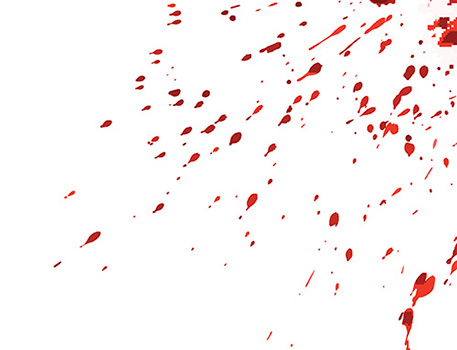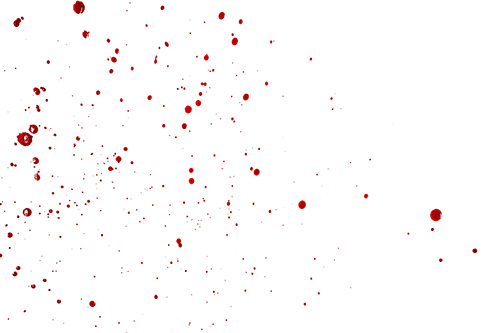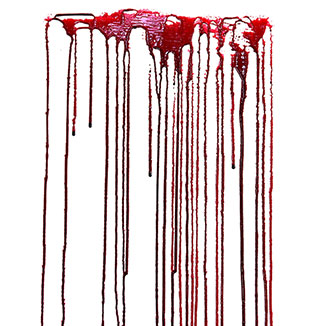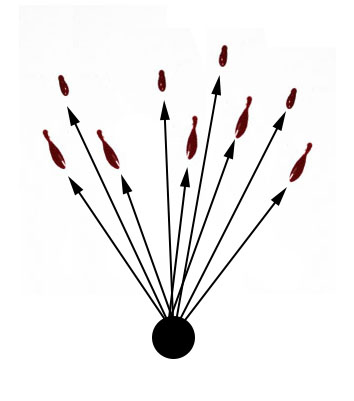Learn
Blood Stains
Blood Spatter
Blood spatter (not splatter) analysis focuses on the physical properties of blood and the patterns that blood produces when different forces are applied. Blood spatter analysis or blood pattern analysis (BPA) helps crime scene investigators figure out what happened at a crime scene. Here are some examples of the types of information that can be determined from this evidence:
Blood Pattern Analysis
Blood pattern analysis (BPA) can determine:
- Date and time of crime
- Type and velocity of weapon
- Movements and position of these involved
- If the assailant was right- or left-handed
- Types of injuries delt
- Whether death was immediate
Reconstruction Theory
Equipped with this information, investigators can develop a reconstruction theory of what happened before, during, and after the crime.
The laws of motion and gravity, physics, and chemistry govern all liquids, including blood. Blood spatter analysis relies on these laws and the predictable ways drops behave when they strike a surface or a force acts on them.
Surface Tension
Blood has a spherical shape due to the surface tension that binds the molecules together. Blood maintains this spherical shape until it hits a surface. The shape that blood takes when it contacts a surface depends on:
- the angle of impact
- the velocity of impact
- the surface material
Types of Blood Stains
There are three types of blood stains that may be left behind at the scene of a crime.

Passive Patterns
We will begin our discussion of blood spatter analysis with the simplest type. Passive patterns are created when blood falls with no outside force on the blood other than gravity. In this case, blood maintains its spherical shape, creating a circular pattern when it impacts the surface.
4Ai2 Blood Drop
Watch the video 4Ai2 Blood drop falling to a 90 degree target (top view) (MFRC).
Open 4Ai2 Blood drop falling to a 90 degree target (top view) (MFRC) in a new window
Note: The presentation may take a moment to load.
Spines
Depending on the texture of the surface, the edges of the circle may be smooth or contain spines.
4Gi2 Blood Drop
Watch the video 4Gi2 Blood drop falling 100 cm to 90 degree wood (MFRC).
Open 4Gi2 Blood drop falling 100 cm to 90 degree wood (MFRC) in a new window
Note: The presentation may take a moment to load.
Blood Drop Examples
Glass - smooth outside edges

Rough surface - scalloping edges with spines

When blood contacts a non-smooth surface or a blood drop that was already present, some of the blood may be forced out, creating satellite stains, which are smaller drops, independent of the parent drop.
6Ad1b Blood Drop
Watch the video 6Ad1b Blood drop falling 100 cm to an existing blood drop (MFRC).
Open 6Ad1b Blood drop falling 100 cm to an existing blood drop (MFRC) in a new window
Note: The presentation may take a moment to load.
Satellite Drops
Were you able to identify multiple satellite drops in the video you just watched?

Passive Blood Droplets
Passive blood droplets can give us an idea of the motion that occurred within the crime scene. For example, if the assailant has been cut and is dripping blood as they move through the crime scene, these passive blood drops will leave a trail around the crime scene that can be visualized even after an attempted clean-up.
The drops The drops also give an indication of high far the blood has fallen.
Knowledge Check #1

According to these images, the further a drop falls the _________ the resulting stain will be.
Answer:
Contract Transfer
If a significant amount of blood is present in one location, a pool can form. This suggests that the person was in that one location for an extended amount of time. Blood in a pool will typically begin to clot.
The next type we will discuss is contact transfer. Contact transfer occurs when a non-bloody surface encounters a bloody one. A bloody shoeprint is an example of a contact transfer. Transfers get lighter and lighter as the object moves away from the source of blood, which can aid investigators in recreating the scene of the crime.

Swipes and Wipes
Swipes and wipes are two types of transfer.
- A swipe occurs if a bloody object is moved across a non-bloody surface. For example, a bloody hand may wipe across a countertop or a body may be dragged, creating swipe marks.
- A wipe occurs when a non-bloody object moves through a blood stain. In a wipe, the original stain is typically still present but may be distorted. Wipes occur when someone attempts to clean-up the scene. The two may be difficult to distinguish at the scene.
Open 10Aa3 Swipe on Plexiglas with a bloodied finger (MFRC) in a new window
Note: The presentation may take a moment to load.
Open 10Ba6 Blood on Plexiglas-wiped with a finger after 240 sec (MFRC) in a new window
Note: The presentation may take a moment to load.
Knowledge Check #2

Blood stains from something being drug across the floor. This is an example of a _____________.
Answer:
Feathering and Projected Bloodstains
In both swipes and wipes, feathering occurs. The feathering shows the direction that the object moved, with the darker portion being where it began, becoming lighter as the object moves away from the source of blood.
The last type of blood stain that we will discuss is the most complex. Projected bloodstains are created when a force other than gravity is applied to the origin of the blood. The force could be external to the body, such as a knife or bullet, or the force could be from coughing or arterial gushing.
Types of Projected Bloodstains
- High Impact - blood stains created with much force such as gunshots, high speed collisions, or explosions. They measure less than 1 mm and usually create a fine mist.

- Medium Impact - blood stains created with more force than gravity such as stabbings or blunt force (like someone getting hit with a baseball bat). They measure 1 to 4mm in size.

- Expiratory Blood - blood stains that are created when blood is projected by the force of air such as when it is coughed or breathed out. These typically form a fine mist with small air bubbles in the drops of blood.

- Arterial Gushing/Spurting - blood stains created when an artery is severed and exposed. The blood is propelled out, forming arcing patterns with large, individual stains accounting for each pump of blood.

- Cast-off - blood stains created when blood is slung from an object onto another surface. This typically occurs when the assailant swings the bloodstained object back before inflicting another blow. The tail will indicate the direction of the motion and counting the arcs can show the minimum number of blows delivered. See an example cast-off blood spatter pattern from a pipe and a pool cue.
Knowledge Check #3
What is the bloodstain with drops created or formed by force of gravity acting alone?
- Transfer
- Passive
- High-impact
- Projected
Answer: b. Passive
Knowledge Check #4
What is the bloodstain created when an exposed blood source is subjected an action or force greater than the force of gravity?
- Transfer
- Passive
- High-impact
- Projected
Answer: d. Projected
Knowledge Check #5
What is the bloodstain created when a wet, bloody surface encounters a secondary surface?
- Transfer
- Passive
- High-impact
- Projected
Answer: a. Transfer
Point of Origin
The pattern created by blood spatters can help investigators determine the point of origin of the blood, as well as what type of weapon was used, what hand the assailant used to attack, and the arrangement of people and items in the room when the attack occurred.
Directly opposite where blood was applied, blood strikes at 90 degrees and maintains a circular shape. As blood is dispersed away from the source of the force, it hits at an angle, making the blood more elliptical. The shape of the blood and the location of the tail and satellite spatters give investigators an idea of the direction the blood came from.

4Ac2 Blood Drop
Watch the video 4Ac2 Blood drop falling to a 30 degree target (front view) (MFRC)
Open 4Ac2 Blood drop falling to a 30 degree target (front view) (MFRC) in a new window
Note: The presentation may take a moment to load.
Knowledge Check #6
A blood droplet that is almost perfectly round would have an angle of impact (AOI) of _____________.
- 45°
- 10°
- 90°
- 30°
Answer: c. 90°
Knowledge Check #7
If the blood spatter's long axis increases, this indicates that the angle of impact has _____________.
Answer:
Point of Convergence
Investigators will look at a blood spatter and identify several parent drops that have a clear shape and tail. Lines will be draw through these in the direction of the origin. The point at which the lines converge is known as the point of convergence. This point tells at what height the blood originated from and gives a 2-dimensional perspective.



Angle of Impact
To determine the 3-dimensional point of origin, investigators will calculate the angle of impact. This is done by measuring the length and width of the blood droplet and plugging in those measurements to the following equation: impact angle = sin-1 (width/length)
- The tail is not included in the measurement of length or width.
- Measurements tells at what height the blood originated from and gives a 2-dimensional perspective.
Angle of Impact Example

Impact angle = sin-1 (arcsine)(width/length)
Angle of Impact (AOI) = sin-1 (2.6 cm/5.9 cm) - Remember that parenthesis come first in the order of operations, then the arcsine is calculated.
AOI = sin-1 (.44)
AOI = 26.2
Point of Origin
A protractor and string (or computer program) are then used to create a line from the blood drop based on the calculated angle. The area at which many strings meet is known as the point of origin, a 3-dimensional location that suggests where the impact occurred.
Blood Stain Analysis
Open A Simplified Guide to Blood Stain Pattern Analysis: How It's Done from A Simplified Guide To Forensic Science by the National Forensic Science Technology Center (NFSTC). Scroll down to the section “How and Where the Analysis is Performed” and watch the video titled “Blood Stain Analysis | Calculating the Area of Convergence and the Area of Origin” (1:16).
[Note: This is a YouTube video. If your school block YouTube, ask your facilitator how you can access this video or watch it at home.]
Knowledge Check #8
A blood droplet has a length of 65 mm and a width of 9 mm. What is the predicted angle of impact?
- 8 degrees
- 15 degrees
- 82 degrees
- 90 degrees
Answer: a. 8 degrees
Void
A void, or area where no blood is present, can give investigators as much information as the blood spatters. The void indicates that something or someone has been moved from the scene. The shape and size of the void can help establish the position of victims and assailants within the scene during the time the spatters were created.
Knowledge Check #9
__________ are small drops that break from the parent drop and can show the direction of blood travel.
- Satellite drops
- Parent drops
- Spines
- Impact drops
Answer: a. Satellite drops
Knowledge Check #10

The _____ shows the location of the blood source using lines or strings in 2-dimensions
- Angle of impact
- Spine
- Area of convergence
- Area of origin
Answer: c. Area of convergence